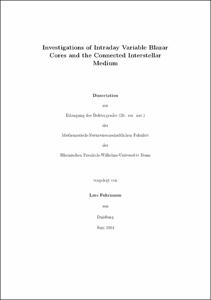Fuhrmann, Lars: Investigations of Intraday Variable Blazar Cores and the Connected Interstellar Medium. - Bonn, 2006. - Dissertation, Rheinische Friedrich-Wilhelms-Universität Bonn.
Online-Ausgabe in bonndoc: https://nbn-resolving.org/urn:nbn:de:hbz:5N-07132
Online-Ausgabe in bonndoc: https://nbn-resolving.org/urn:nbn:de:hbz:5N-07132
@phdthesis{handle:20.500.11811/2594,
urn: https://nbn-resolving.org/urn:nbn:de:hbz:5N-07132,
author = {{Lars Fuhrmann}},
title = {Investigations of Intraday Variable Blazar Cores and the Connected Interstellar Medium},
school = {Rheinische Friedrich-Wilhelms-Universität Bonn},
year = 2006,
note = {The work presented here is an attempt to shed further light upon the phenomenon of short-term radio variations (Intraday Variability, IDV) often observed in compact blazar cores. Three different new observational approaches were performed with particular emphasis on the connected scattering material in the local ISM.
I present the results of a new Effelsberg 4.85 GHz IDV monitoring over the period of 2.5 years aiming the detection of seasonal cycles in the variability time scale of "classical" type-II IDV sources. While the most promising new candidate turned out to be BL Lac 0954+658, the annual cycle in quasar 0917+624 proposed earlier could not be confirmed due to the sudden death of rapid variability in this source since 2000. Here, additional 15 GHz VLBI observations were performed in parallel to our IDV monitoring suggesting an extremely quenched scattering scenario and a possible connection between intrinsic structural changes on (sub-) mas-scale and the dramatic changes in IDV characteristics. The attempt to detect an intrinsic contribution to the IDV pattern using high frequency IDV observations revealed no significant variations in three sources including BL Lac 0716+714 for which IDV in the mm-band was detected earlier. The results of a short multi-frequency observation of the 'rapid scintillator' J1819+3845 are in agreement with weak interstellar scintillation of a point source due to enhanced turbulence in the local bubble wall at a distance of about 15pc. Finally, the possibility of a direct detection of the scattering medium in front of IDV and extreme scattering event (ESE) sources is examined and discussed with emphasis on the various components of the (local) ISM, such as the WIM, local bubble, adjacent bubble/loop structures and their turbulent interaction zones. First spectral line observations led to the detection of a high latitude molecular cloud intervening the line of sight to 0954+658. Here, several findings suggest that the observed scattering effects (IDV and ESEs) are produced by the ionized CII component provided by the photo-dissociation region surrounding the CO-cloud.},
url = {https://hdl.handle.net/20.500.11811/2594}
}
urn: https://nbn-resolving.org/urn:nbn:de:hbz:5N-07132,
author = {{Lars Fuhrmann}},
title = {Investigations of Intraday Variable Blazar Cores and the Connected Interstellar Medium},
school = {Rheinische Friedrich-Wilhelms-Universität Bonn},
year = 2006,
note = {The work presented here is an attempt to shed further light upon the phenomenon of short-term radio variations (Intraday Variability, IDV) often observed in compact blazar cores. Three different new observational approaches were performed with particular emphasis on the connected scattering material in the local ISM.
I present the results of a new Effelsberg 4.85 GHz IDV monitoring over the period of 2.5 years aiming the detection of seasonal cycles in the variability time scale of "classical" type-II IDV sources. While the most promising new candidate turned out to be BL Lac 0954+658, the annual cycle in quasar 0917+624 proposed earlier could not be confirmed due to the sudden death of rapid variability in this source since 2000. Here, additional 15 GHz VLBI observations were performed in parallel to our IDV monitoring suggesting an extremely quenched scattering scenario and a possible connection between intrinsic structural changes on (sub-) mas-scale and the dramatic changes in IDV characteristics. The attempt to detect an intrinsic contribution to the IDV pattern using high frequency IDV observations revealed no significant variations in three sources including BL Lac 0716+714 for which IDV in the mm-band was detected earlier. The results of a short multi-frequency observation of the 'rapid scintillator' J1819+3845 are in agreement with weak interstellar scintillation of a point source due to enhanced turbulence in the local bubble wall at a distance of about 15pc. Finally, the possibility of a direct detection of the scattering medium in front of IDV and extreme scattering event (ESE) sources is examined and discussed with emphasis on the various components of the (local) ISM, such as the WIM, local bubble, adjacent bubble/loop structures and their turbulent interaction zones. First spectral line observations led to the detection of a high latitude molecular cloud intervening the line of sight to 0954+658. Here, several findings suggest that the observed scattering effects (IDV and ESEs) are produced by the ionized CII component provided by the photo-dissociation region surrounding the CO-cloud.},
url = {https://hdl.handle.net/20.500.11811/2594}
}






